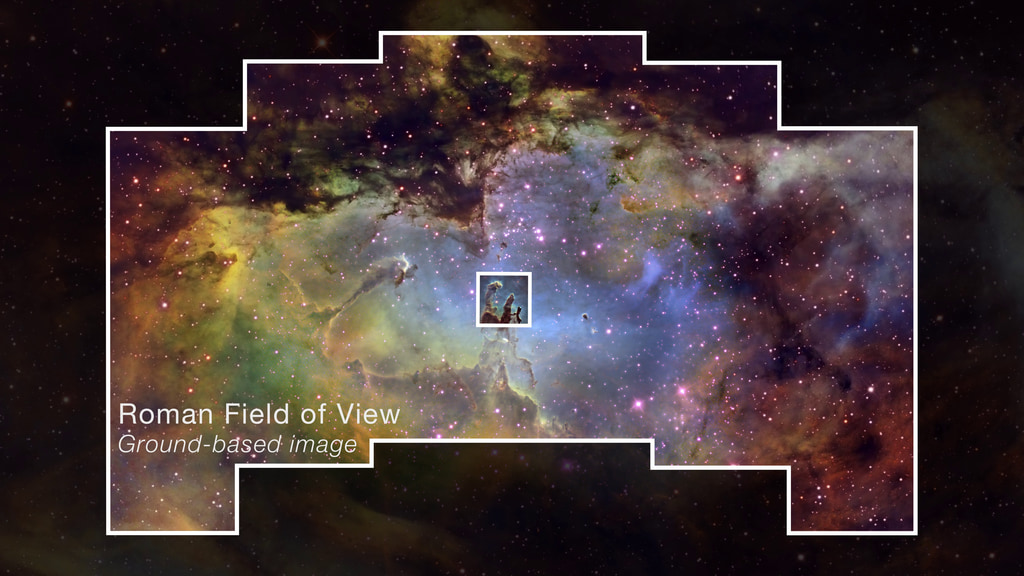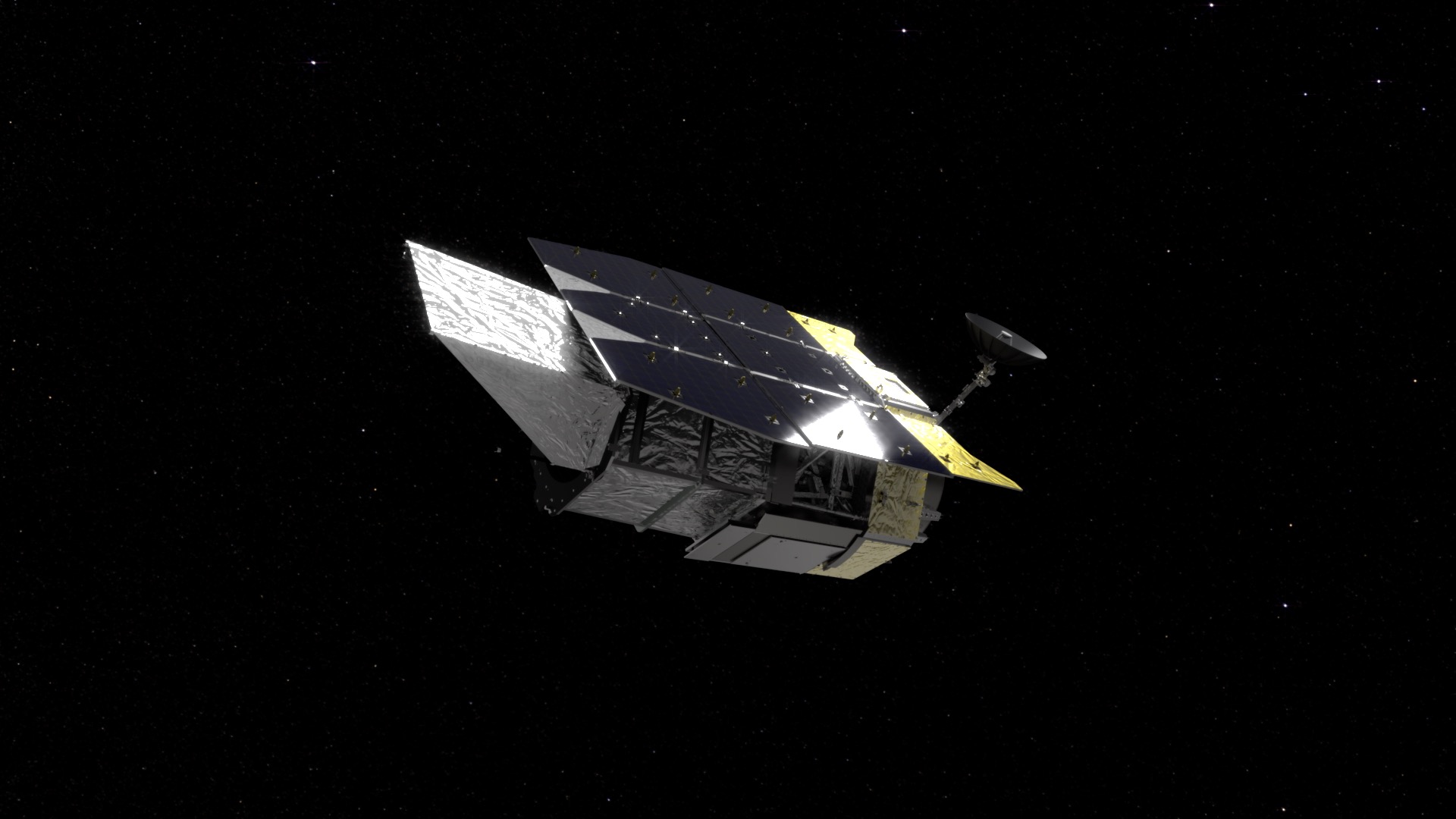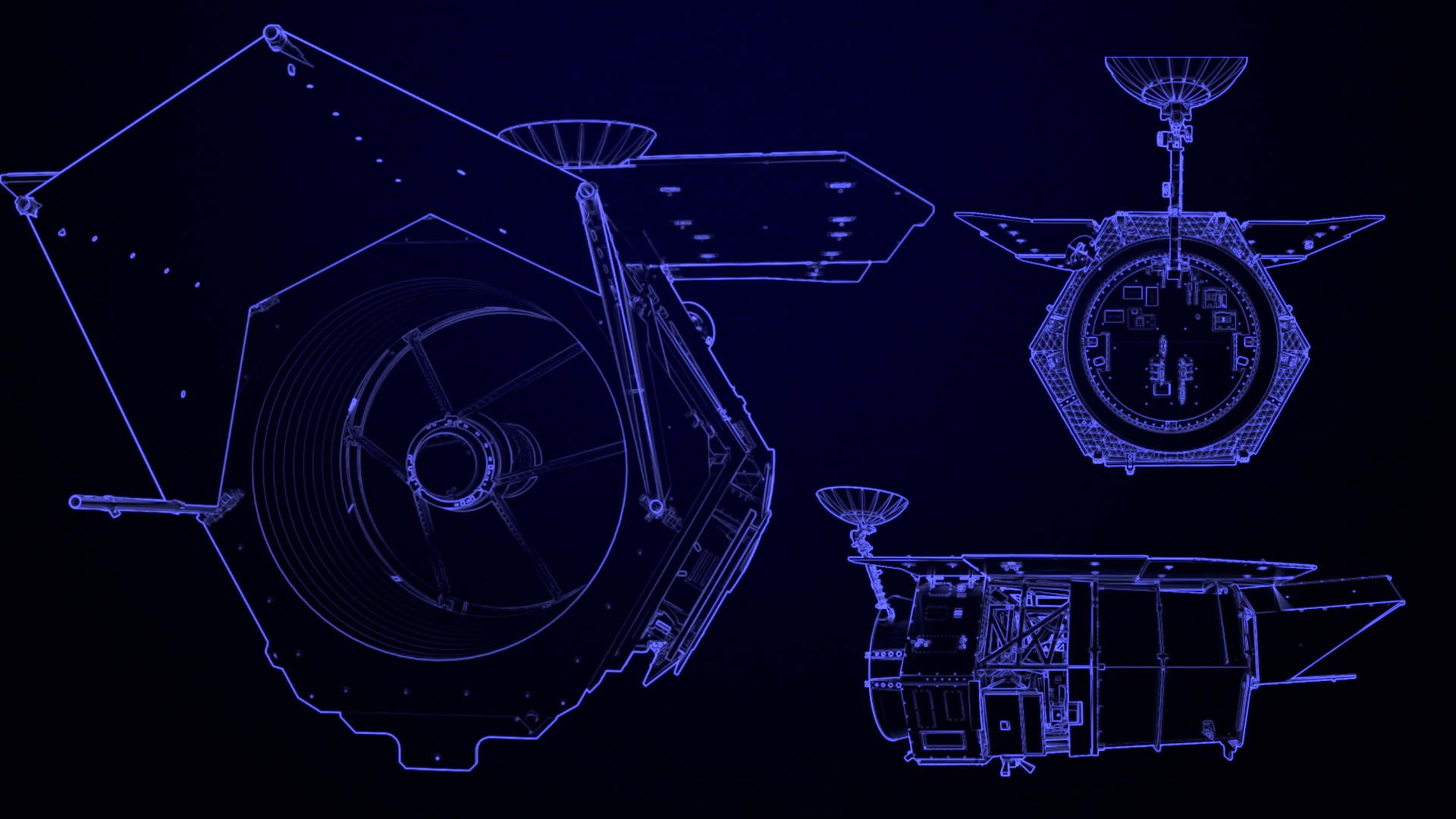Expanding Our View (2022 STScI presentation)

Complete PowerPoint file with all slides and notes

Slide #1 – Onscreen before presentation begins and during introduction
Credit: STScI, NASA

- Roman FOV compared with familiar Hubble Space Telescope
Image credits:
Wide view: Composite image of the National Science Foundation’s 0.9-meter telescope at Kitt Peak National Observatory (Credit: T.A. Rector (NRAO/AUI/NSF and NOIRLab/NSF/AURA) and B.A. Wolpa (NOIRLab/NSF/AURA), and an image by amateur astronomer Liam Murphy.
Center image: NASA, ESA, and the Hubble Heritage Team (STScI/AURA)
Image composition: by L. Hustak (STScI)

- The namesake: Nancy Grace Roman
The image on this slide shows Dr. Roman at work and provides an opportunity to discuss her contributions to science.
Credit: STScI, NASA

- History of major space-based missions resulting from Decadal Surveys – discoveries of one mission lead to the innovations in the next
Credit: STScI, NASA, J. Kang (STScI)

- Major missions comparison—Hubble, Webb, Roman
Credit: A. James (STScI)

- Facts & Figures list
Credit: STScI, NASA

- Introducing Roman’s instruments
Credit: STScI, NASA's Goddard Space Flight Center

- The Wide Field Instrument
Credit: STScI, NASA's Goddard Space Flight Center

- The Coronagraph Instrument
Credit: STScI, NASA's Goddard Space Flight Center

- Start of science section
Credit: STScI, NASA

- Roman Science—Planets by the thousands-intro
Credit: STScI, NASA

- Planets by the thousands—exoplanets & microlensing
This artistic rendering illustrates the diversity of planets around a diversity of stars
Credit: STScI, ESO, M. Kornmesser

- Planets by the thousands—exoplanets & the coronagraph
This near-IR, ground-based image from the Keck Telescope was created using a coronagraph to block out the young star at the center. Even with some stray starlight entering the telescope, researchers were able detect four Jupiter-mass objects orbiting around the young star.
This image was taken from the ground. Roman will be observing from above Earth’s atmosphere, where it will have a much sharper view. In addition, Roman’s “inner working angle” will be smaller than current ground-based telescopes—i.e., we can image closer to the star itself to look for planets that are orbiting more closely to its host star.
Credit: STScI, Jason Wang (Caltech)/Christian Marois (NRC Herzberg)

- Planets by the thousands—the Solar System
Credit: STScI, NASA, J. Kang (STScI)

- Roman Science—Stars by the billions-intro
Credit: STScI, Zolt Levay | Monument Valley Navajo Tribal Park, Arizona ǀ 2016

- Roman Science—Stars by the billions—stellar lifecycle
Credit: STScI
Background image: Nathan Smith, University of Minnesota/NOIRLab/NOAO/AURA/NSF
Mosaic: Hubble Image: NASA, ESA, N. Smith (University of California, Berkeley), and The Hubble Heritage Team (STScI/AURA); CTIO Image: N. Smith (University of Arizona) and NOAO/AURA/NSF
Mystic Mt.: NASA, ESA, and M. Livio and the Hubble 20th Anniversary Team (STScI)
Eta Carina: NASA, ESA, N. Smith (University of Arizona), and J. Morse (BoldlyGo Institute)
Trumpler 14: NASA, ESA, and J. Maíz Apellániz (Institute of Astrophysics of Andalusia, Spain); acknowledgment: N. Smith (University of Arizona)
Composition: A. Pagan (STScI)

- Roman Science—Stars by the billions—core of the Milky Way
This star field is a simulated image created by Matthew Penny.
Credit: STScI, Matthew T. Penny (Ohio State University)

- Roman Science—Stars by the billions—stars in nearby galaxies
Credit: STScI
Background image: Digitized Sky Survey and R. Gendler
Roman simulation images: NASA, STScI, and B. F. Williams (University of Washington)
Image composition: J. DePasquale (STScI)

- Roman Science—Galaxies by the millions-intro
19th century sketches of galaxies by the Earl of Rosse; From left to right: Whirlpool Galaxy (M51), the Triangulum Galaxy (M33), and M99
Credit: STScI, William Parsons, the Third Earl of Rosse (public domain)

- Roman Science—Galaxies by the millions—nearby galaxies
The slide image features galaxy UGC 2885 (nicknamed Rubin's Galaxy after astronomer Vera Rubin). Hubble's view is inset, and the Roman field of view is shown with the grid of squares. Roman will capture the entire halo of galaxies like Rubin in a single pointing; the size of the galaxy’s halo is estimated and shown here as the purple circle.
Credit: STScI,
Hubble image: NASA, ESA, and B. Holwerda (University of Louisville)
Background image: Digitized Sky Survey
Image Composition: J. DePasquale (STScI)

- Roman Science—Galaxies by the millions—diversity
Credit: STScI
Background Image: Digitized Sky Survey
Galaxy Images: NASA, ESA, M. Sun (University of Alabama), W. Cramer and J. Kenney (Yale University), J. Mack (STScI), and J. Madrid (Australian Telescope National Facility) and Hubble Heritage Team (STScI/AURA).
Image Composition: A. Pagan (STScI)

- Roman Science—Galaxies by the millions—early universe
Credit: STScI
Image credit: NASA, ESA, Anton M. Koekemoer (STScI), Alyssa Pagan (STScI)
Background image acknowledgement: Digitized Sky Survey
Hubble Ultra Deep Field (2004): NASA, ESA, S. Beckwith (STScI), and the HUDF Team

- Roman Science—Fundamental physics-intro
Credit: STScI, Pete Linforth

- Roman Science—Fundamental physics—structure of the universe
Simulated Roman star-forming galaxy distribution data, displaying ~215,000 galaxies of a much larger 5-million galaxy simulated galaxy catalog.
Credit: STScI
Data provided by Z. Zhai and Y. Wang, Caltech/IPAC, and A. Benson, Carnegie Observatories
Data Visualization: J. DePasquale and D. Player, STScI.

- Roman Science—Fundamental physics—dark energy
Arrow in the image points to a Type IA supernova, which are used to calculate and track the universe’s expansion.
Credit: STScI, B. J. Fulton/Las Cumbres Observatory Global Telescope Network

- Roman Science—Fundamental physics—Dark matter
Credit: STScI, NASA, ESA, and J. Lotz, M. Mountain, A. Koekemoer, and the HFF Team (STScI)

- Roman Science—Fundamental physics—New physics
Credit: STScI, NASA, ESA, and J. Olmsted (STScI)

- Roman’s efficiency—more of the sky in less time
This simulated image illustrates the wide range of science enabled by Roman's extremely wide field of view and exquisite resolution. The yellow squares—which all contain background imagery simulated using data from Hubble’s Cosmic Assembly Near-infrared Deep Extragalactic Survey (CANDELS) program—outline the area Roman can capture in a single observation. A blue square shows the field of view of Hubble’s Wide Field Camera 3 for comparison.
Credit: Benjamin Williams, David Weinberg, Anil Seth, Eric Bell, Dave Sand, Dominic Benford, and the WINGS Science Investigation Team
Image Composition: Z. Levy (STScI)

- Roman’s big data visualized—comparison with Hubble
Credit: Z. Levy (STScI)

- Roman and other missions
Credit: A. James (STScI)

- Conclusion summary slide
Credit: STScI
Wide view: Composite image of NSF’s 0.9-meter telescope at Kitt Peak National Observatory (Credit: T.A. Rector (NRAO/AUI/NSF and NOIRLab/NSF/AURA) and B.A. Wolpa (NOIRLab/NSF/AURA)
and an image by amateur astronomer Liam Murphy.
Center image: NASA, ESA, and the Hubble Heritage Team (STScI/AURA)
Image composition: by L. Hustak (STScI)
Credits
Please give credit for this item to:
STScI. However, individual items should be credited as indicated above.
-
Producer
- Brandon Lawton (STScI)
-
Support
- Scott Wiessinger (KBR Wyle Services, LLC)
Release date
This page was originally published on Tuesday, July 5, 2022.
This page was last updated on Wednesday, May 3, 2023 at 11:44 AM EDT.


